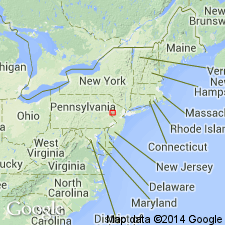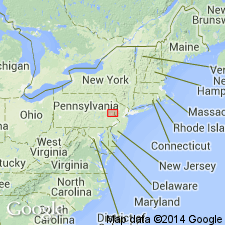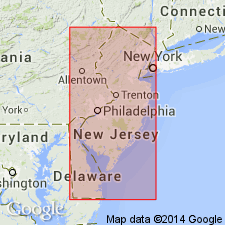
- Usage in publication:
-
- Ramseyburg Member*
- Modifications:
-
- Named
- Dominant lithology:
-
- Graywacke
- Slate
- AAPG geologic province:
-
- Appalachian basin
Summary:
Named Ramseyburg for Ramseyburg, Warren Co., NJ. The member includes the same sequence of rocks called the middle sandy member by Behre (1927) and in addition includes the unit he called the Bangor Beds. These are included in the Ramseyburg because they have a prominent interval of graywacke at the top which provides an easily mappable upper contact in areas where exposures are poor. The Ramseyburg consists of alternating beds of claystone slate and light-gray to medium-gray, light-brown- to yellowish-brown-weathering, thin- to thick-bedded graywacke and graywacke siltstone. The slate in the lower cycles is identical with the underlying Bushkill Member in the lower 200 feet. Higher in the unit, the slate becomes progressively thicker bedded and terminates in slate "runs" like those of the overlying Pen Argyl Member, although thin-bedded ribbon slate is common throughout. Graywacke constitutes 20-30 percent of unit. Texturally, most of the unit is fine grained, but medium-grained sandstone and siltstone are also common. Fine conglomeratic beds have been noted locally. The unit is about 2800 feet thick. Fossil collections suggest that the member is of Maysvillian age.
Source: GNU records (USGS DDS-6; Reston GNULEX).

- Usage in publication:
-
- Ramseyburg Member*
- Modifications:
-
- Areal extent
- AAPG geologic province:
-
- Appalachian basin
Summary:
Ramseyburg Member of Martinsburg extends from the New Tripoli quad, PA, to the Middletown quad, [Orange Co], southeastern NY. In study area of Wallkill Valley, informally named sandstone at Pine Bush is possible correlative (in part).
Source: GNU records (USGS DDS-6; Reston GNULEX).

- Usage in publication:
-
- Ramseyburg Member
- Modifications:
-
- Biostratigraphic dating
- AAPG geologic province:
-
- Appalachian basin
Summary:
Paleontological collections from northern NJ, eastern PA, and southern NY confirm that Martinsburg can be divided into three members according to the nomenclature of Drake and Epstein (1967): Bushkill, Ramseyburg, and Pen Argyl Members. Bushkill and Pen Argyl are not age equivalents as has been suggested by other authors. Data show that Pen Argyl and Ramseyburg Members are definitely younger than Bushkill, but are insufficient to place upper limit on Pen Argyl.
Source: GNU records (USGS DDS-6; Reston GNULEX).
For more information, please contact Nancy Stamm, Geologic Names Committee Secretary.
Asterisk (*) indicates published by U.S. Geological Survey authors.
"No current usage" (†) implies that a name has been abandoned or has fallen into disuse. Former usage and, if known, replacement name given in parentheses ( ).
Slash (/) indicates name conflicts with nomenclatural guidelines (CSN, 1933; ACSN, 1961, 1970; NACSN, 1983, 2005, 2021). May be explained within brackets ([ ]).

